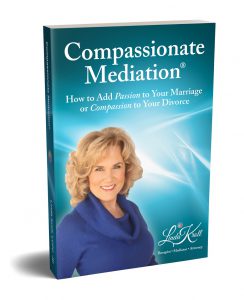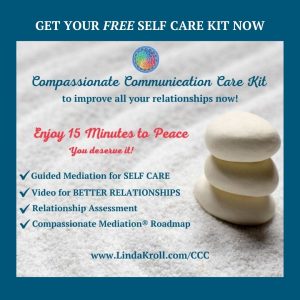
Compassionate Mediation Helps!
As a therapist, coach, mediator, attorney, counselor or clergy, we are called upon to help individuals and couples, affected by the quarantine, who could use new skills to resolve conflict. And that is what we do with Compassionate Mediation. We help each party understand the suffering of the other – so that mutual empathy can heal and transform the relationship.
Zen Master Thich Nhat Hanh a global spiritual leader offering advice on helping people resolve conflict. Here is what he said:
“To reconcile conflicting parties, we must have the ability to understand the suffering of both sides.
If we take sides, it is impossible to do the work of reconciliation. And humans want to take sides. That is why the situation gets worse and worse.
Are there people who are still available to both sides? They need not do much.
They need only do one thing, go to one side and tell all about the suffering endured by the other side, and go to the other side and tell all about the suffering endured by this side.
That is our chance for peace. That can change the situation.”
And that is what we do with Compassionate Mediation.
(The following video is a response to a question in my Compassionate Mediation® Tools for Your Practice course, which is now open for the next training. Please join me!)https://lindakroll.lpages.co/tools3/
We give each party — or if you're working with an individual, give the individual — a chance to come from their highest SELF, let go of their limiting beliefs, unburden pain from the past, and relate from their heart.
And then when they relate from their heart, they can talk about their feelings that they've exiled — the hurt, the sadness, the fear — and their partner can listen to that.Their partner can't listen to the judgments, the “you” messages — “You always do this…. You never do that…“
Unfortunately, and especially now with all the quarantine, a lot of people are getting into some very bad habits of communicating. Maybe they're fighting more.Maybe they're distancing more. Maybe they're doing the dance of fighting and distancing.
Now more than ever, the skill of Compassionate Mediation can be something that you can use with your current clients or future clients to teach them a new way to communicate. Compassionate Mediation starts with compassionate communication.
How Does Compassionate Mediation Training differ from other trainings?
The Compassionate Mediation Tools course is my introductory course. It's four and a half hours, and it's something that I wanted to offer so that you get a general feel for the kinds of tools that I teach in the process.
Starting this fall, I'm going to have a certification process. And that certification process is going to take you from the very beginning of working with an individual or couple to all of the different tributaries that they can go into — creating a new marriage, deciding on a separation, deciding if they want to get divorced — and giving you the scripts that I used to have all those dialogues.
For instance, in the Compassionate Mediation Tools, in lesson one and lesson two, you actually get the script I use to introduce IFS (Internal Family Systems therapy) Self and Parts. You get the script I use to talk about empathy and how I share that with people.
In the third session, we talk about the legal and financial.
I know that's just the tip of the iceberg. There's so much more to talk about. And what I do in this certification process is I give you the information you need to stay one step ahead of your clients, or many steps ahead of your clients.
But you don't need to know the law. You don't need to be a financial planner.
You will have a basic understanding of important information that you can bring up and share with your clients whenever they bring up a subject – about money, parenting, the decisions to be made individually and together.
You're trained in therapy or coaching or helping them, what you're going to be able to do is talk about the content of any issue relevant to their future.
You can offer information about CONTENT and then PROCESS FEELINGS.
If you're talking about Property Division or Child Support or Maintenance – you’ll have the tools and skill set to feel confident offering basic information.
What you need to do is talk about the feelings that come up around these subjects.
And far too often we'll be counseling someone and they'll decide they're thinking of a divorce, and they want to go to a mediator or they want to hire an attorney. I mention to anyone thinking of the divorce that mediation is always the best way to go, whether it's Compassionate Mediation or any other mediation, because it gives them a chance to speak with each other.
Compassionate Mediation is an opportunity for healing and a new and better relationship together.
In Compassionate Mediation, we're teaching our clients a way to be more SELF-led, to compassionately communicate, to learn how to empathize, and then to talk about all the different options they have.
Another thing we're doing in Compassionate Mediation is we're taking them off the ledge.
And if you know what I mean, it's when an individual or a couple comes into your office and they think they have to act now. They think they have to jump. They've reached the end of their rope. They're so tired of the same old, same old that they need to make a decision and they need to make it fast. (Deep breath here.)
The important thing is not what they decide, but are they deciding from their highest and best self?
If your clients are not “in SELF”, they are just reacting. They're reacting to their own parts. They're reacting to their partner's parts.
Especially now with COVID, there might be a lot of people who are fighting all the time.
So when Thich Nhat Hanh is talking, he wants us to help the people not get stuck in what their two extreme angry parts may be saying to each other.
We begin to recognize that both members of the couple are trying to cope as best they can — to be cool or to work too hard or do whatever they can to manage their feelings.
But inside there is an inner child in each of them who is scared, who is sad, who is hurt, who is angry — and helping them learn how to speak for those parts is what we do.
Compassionate Mediation is a space to talk about EVERYTHING.
If either one or both parties has thought about a separation or divorce — which often happens in a relationship and often happens in marriage counseling — it is sometimes difficult to discuss.
In marriage counseling, many people don't bring it the parts that have considered leaving because they think that if they're in marriage counseling, all they're there to do is to make the marriage better.
And unfortunately, one or both of them may have already be considering what would it be like to separate? What would it be like to find somebody new? What would it be like to get out of this union?
But because they're exiling that part of themselves, they're only showing up with a part that's trying to be invested in counseling, but they're not fully invested in counseling because they're not talking about the part that's thought about leaving.
So what we do in Compassionate Mediation is we make it safe for all parts to come in, the parts that are scared, the parts that are worried, the parts that are angry, the parts that feel betrayed, and the parts that think, I might want to end this.
What would that look like? And that's why in one of the modules, I talk about how you talk to the initiator and how you talk to the non-initiator.
Talking with the One who wants to STAY and the One who may want to LEAVE.
The initiator is the party in the couple, the one member of the couple, that really would like to separate or divorce. And I tell that person that if they don't process some of the feelings that led to their desire to leave, their partner is not going to be part of this process.
Their partner is going to pull out. So then they'd be left with having to hire an attorney, file for divorce, their partner would have to file a response a year or two later, thousands of dollars later, maybe they'll get divorced. So I tell the initiator, take the time to learn how to communicate, to process the feelings that got you here.
And I tell the non-initiator, the person that doesn't want to think about a divorce, doesn't want to think about a separation, is totally obsessed with staying together, that if they don't open their mind to consider the possibility of leaving, the partner that wants to separate or divorce isn't going to stay in this process, because it's going to feel too much like marriage counseling.
So they have to meet in the middle where the person who wants out talks about feelings, the person that wants to stay talks about what would it look like if I left, and you hold the space for that whole conversation.
You will help clients talk about everything – money and all subjects.
And whatever topic they bring up, if they bring up money and how money is divided between the two of them, that's a subject that could go on for weeks or months.
Because when you talk about money, you have to talk about all the parts that are triggered about that conversation. You can talk about the legacy burdens that each of them brought into the relationship, about the roles and responsibilities. You can talk about their limiting beliefs or the way they've managed or the parts they've exiled.
And at the same time, you will know enough to give them feedback about how to talk about money.
You can acquire the tools to help your clients talk about all their issues and resolve them from their best SELF for the highest good for all concerned.
You can also increase you income, expertise, and impact as you offer this new paradigm of conflict resolution and relationship healing.
My next LIVE Course starts soon. Please join me! Compassionate Mediation Tools for Your Practice Now.



